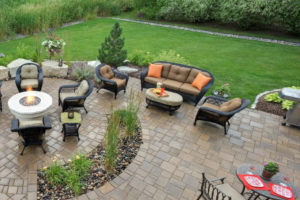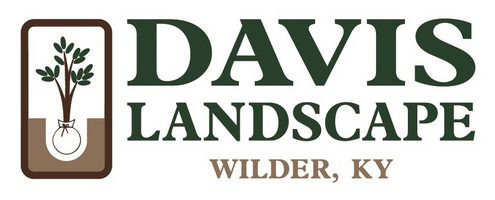
Patio pavers remain a top choice for patios and walkways throughout the tri-state area. Why? Because they are easy to maintain, resistant to our varying weather conditions, durable, fade-resistant, and they look phenomenal when installed right. Not to mention, patio pavers come in an assortment of colors, shapes, and styles allowing you to bring your outdoor living space dreams to life. They offer a better look than concrete, are more affordable than natural stone, and can completely transform your backyard and enhance the look of your walkway.
How Are Pavers Made?
The majority of concrete pavers are made using sand, gravel, and cement. Once the ingredients have been mixed together and pressed into the desired shape, they go through a process that will create pigmentation throughout the paver to give them a custom color. Different ingredient mixes and finishing methods are used to achieve a smooth or textured look.
How Do You Prevent Weed Growth Between Pavers?
Polymeric sand is used to help prevent weeds from growing between pavers. Polymeric sand is a combination of polymer (a binding agent) and sand. This is the best choice to use between your pavers as it doesn’t allow weeds to pop up between the stones. In addition, polymeric sand keeps ants and other pests from making their way between each paver and compromising the structure beneath the surface. This sand will not only outperform and outlast the typical jointing sand, but it is also incredibly resistant to the elements, weeds, and pests.
How Much Maintenance is Required?
Patio pavers are actually super easy to care for. You’ll have to sweep them and hose them down from time-to-time depending on use but that is all that is necessary. We advise our clients to keep leaves swept off their pavers in the fall to prevent natural stains, but if you don’t get around to it a low-power pressure washer can effectively remove any staining.
As with all things outdoors, pavers might be slightly affected by weather conditions and rotting leaves over the years. One option you have is to have your paver patio or walkway sealed. Many homeowners choose sealing pavers to really enhance the color and make the pavers more resistant to staining and easier to maintain. At Davis Landscaping, we use the Seal ‘n Lock System as it is more ecologically-friendly and safer for children and pets.
Note: Shaded areas that see more moisture are naturally more prone to moss growth. If you notice moss growing in your joints, try using 5 parts water to 1 part bleach to remove the moss. You can apply the mixture using a watering can or siphon sprayer then lightly scrub the surface using a nylon brush. Be sure to thoroughly rinse the pavers when you are finished.
What Gives Pavers The ‘Wet’ Look?
Sealers. Not only do sealers provide necessary protection for paver patios and walkways, but they also give that desired ‘wet’ look. You’ll want to wait to apply a sealer until after your patio or walkway has weathered one winter. This ensures that all efflorescence has worn off. Worried about moss? Some sealers have moss inhibitors built in their formula.
Why Is There White Residue On Some Of My Pavers?
This white residue is known as efflorescence and is quite common in all clay brick and concrete products. Sometimes when the mineral salts from the cement and aggregates that are embedded in the product become dislodged by absorbed water and are transported to the surface – this is not a defect with the product. Generally, the white residue will disappear within the first three months but sometimes it will take up to two years after being manufactured.
Will Extremely Cold Temperatures Cause Pavers To Crack?
Pavers will remain stable and whole as long as they have been properly installed. It is the joints between pavers that create flexibility that help them avoid cracking while still allowing for subtle movement. You will find that pavers are stronger and less prone to cracking than poured concrete.
How Easy Is It To Repair Patio Pavers?
Unlike poured concrete, patio pavers move independently making it less likely that they will crack. This means that repairs are simple. In the event that a paver becomes cracked, all you need to do is pull it up, make the repair, and position it back in place.
Slabs V. Pavers – What’s The Difference?
Slabs and pavers are both durable, low maintenance, and come in plenty of shapes and colors for a custom look. The biggest differences between the two are design and application possibilities and, on occasion, the load they are able to bear. If you are designing a space that will see a fair amount of foot traffic, like a walkway, patio, pool deck, etc., then pavers or slabs are good choices. Slabs are not ideal for vehicular traffic. Create a combination of the two for an eye-catching look.
Summing It Up
Pavers are durable and versatile meaning they will offer both form and function to your outdoor living space. At Davis Landscape, we offer experience in patio design and installation. We are proud of the skill and knowledge we have to give our clients as we help them create the backyard of their dreams. Let us help you create a patio or walkway that is sure to last.
Contact Davis Landscape for your free consultation today! We look forward to discussing your project ideas.
Contact Us (859-781-0677) for More Information!
—

About Davis Landscaping
Davis Landscape Design & Installation has been providing landscaping services to customers in Northern Kentucky and Greater Cincinnati since 1965! We know that the landscape design process can be overwhelming, so we work with you tirelessly to better understand your vision. At Davis Landscape Design & Installation, we’re on your team and we know how to listen and deliver.
